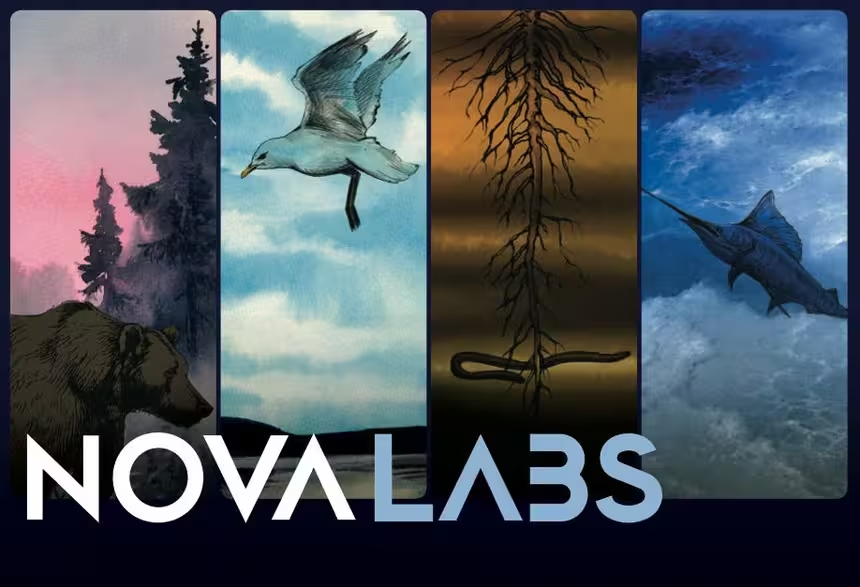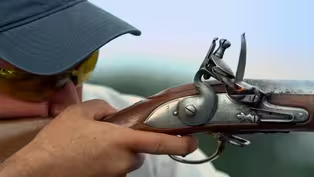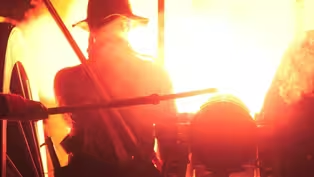
The World’s First Combat Submarine
Clip: Season 52 Episode 7 | 10m 49sVideo has Closed Captions
Its nickname was the “Turtle”.
During the American Revolution, an American inventor developed an underwater vessel that could destroy British ships by attaching a bomb to the hull of a ship. These are some of its unique features.
Problems playing video? | Closed Captioning Feedback
Problems playing video? | Closed Captioning Feedback
National Corporate funding for NOVA is provided by Carlisle Companies and Viking Cruises. Major funding for NOVA is provided by the NOVA Science Trust, the Corporation for Public Broadcasting, and PBS viewers.

The World’s First Combat Submarine
Clip: Season 52 Episode 7 | 10m 49sVideo has Closed Captions
During the American Revolution, an American inventor developed an underwater vessel that could destroy British ships by attaching a bomb to the hull of a ship. These are some of its unique features.
Problems playing video? | Closed Captioning Feedback
How to Watch NOVA
NOVA is available to stream on pbs.org and the free PBS App, available on iPhone, Apple TV, Android TV, Android smartphones, Amazon Fire TV, Amazon Fire Tablet, Roku, Samsung Smart TV, and Vizio.
Buy Now

NOVA Labs
NOVA Labs is a free digital platform that engages teens and lifelong learners in games and interactives that foster authentic scientific exploration. Participants take part in real-world investigations by visualizing, analyzing, and playing with the same data that scientists use.Providing Support for PBS.org
Learn Moreabout PBS online sponsorship- This is a model of the first combat submarine.
Now, I say model, because the original doesn't exist.
All we have is a few hints and clues from subsequent writings.
- [Narrator] The writings come from American inventor David Bushnell.
- [Speaker] The external shape of the submarine vessel bore some resemblance to two upper tortoise shells of equal size joined together.
- [Narrator] It was later nicknamed the Turtle.
- First, you've got the overall shape.
It's using the technology of a barrel.
It's thick oak staves bound together with iron hoops.
It's not quite barrel-shaped though, and the reason for that is because you need space inside for an operator to sit, so that's going to broaden it in the middle, and you need space at the top for a hatch for the operator to get in.
At first glance, it immediately reminds you of a space capsule.
But what it is, in fact, is a time capsule, a time capsule of contemporary technologies.
You've got these pedals here, so the operator is pedaling away.
This is powered by pedal power.
And they are driving a propeller.
- [Narrator] The concept of the propeller dates back to Greek mathematician Archimedes.
His Archimedes' screw famously moved water using a spiral blade inside a tube.
Bushnell took this concept and located a blade on the outside of his Turtle.
This is thought to be one of the first practical applications of a propeller.
Along with a rudder, the Turtle has all the components needed to maneuver on the surface.
- A particular feature of the outside of the vessel is this hatch at the top here.
It's got these watertight windows so he has got some natural light inside.
Then above there, these strange-looking things are really snorkels, so that when it's above water, it's fully ventilated.
- [Narrator] Using the windows, the operator could maneuver on the surface to locate and position the Turtle next to a ship.
It is then ready to descend by filling the area at the base of the vessel, known as the bilges.
To do that, the operator kicks a lever.
- This will flood the bilges down there with water.
- [Narrator] Under the surface, a second propeller is used to lower or raise the Turtle.
(water burbling) Once submerged in darkness, the operator has only two instruments for guidance.
- This is a barometer.
It has a little cork in it, and each of these marks on the glass tube represents a fathom, that's about six feet.
So, as he sees the cork bobbing down, he knows he's going down another six feet.
How can he see that underwater?
Because it's been covered with a fungus called foxfire, which is luminous, it glows in the dark.
And over here is a compass, which, again, the needle on the compass has been coated with this luminous fungus so he can read his heading.
- [Narrator] The Turtle is designed to move into position armed with a bomb to blow up its target.
- So, assuming that we've now got to the right depth, we now need to attach the payload, and that's this crank here.
This crank operates that drill at the top and that bores its way up into the hull of a ship.
- [Narrator] The drill is attached to the bomb by a rope.
Once connected, the Turtle detaches itself, leaving the explosive secured to the ship.
- And now, you've gotta get outta here, so you pedal away.
When you want to surface, you use these two hand pumps, yet more exertion to save your life, pumping away to get that water out of the bilges.
But my goodness, that's a heck of a lot of work to get to that stage.
- [Narrator] Employed to carry out this dangerous mission, 27-year-old American, Ezra Lee.
The plan, drive into New York Harbor and blow up the British flagship HMS Eagle.
But how could Ezra Lee attach a bomb big enough to sink the British ship and get away safely?
Inventor David Bushnell's writings provide some clues, allowing pyrotechnics expert John Hargreaves to figure out how it was supposed to happen.
- I've rigged this as a demonstration.
This is pretty much the size of the bomb that would've been on the Turtle.
- That holds the gunpowder?
- [John] Correct.
150 pounds.
- How do we get a spark to it?
- Well, in the references to Bushnell's machine, they show a flintlock mechanism.
- So, this little pocket pistol- - Correct.
- Which has got this flintlock here.
So, that flint strikes that which creates the spark.
- [Narrator] The pistol's muzzle is screwed into the barrel.
When it's fired, it will ignite the gunpowder.
But Ezra Lee would need time to escape before it exploded.
Bushnell had a plan.
- [Speaker] Within the magazine was an apparatus constructed to run any proposed length of time under 12 hours.
- This is a specialist clock.
It is a very early 19th century version actually, but is the nearest thing I can find to the right mechanism.
- [Narrator] The mechanism John thinks Bushnell used comes from a period pocket watch.
- The pocket watch had been around at the beginning of the 17th century.
It was a pretty rare thing, and they were all watches like this.
The clock is going to count down to zero.
When it gets to zero, it pulls a lever, which I have attached to the trigger mechanism of my pistol.
So, it pulls the trigger and fires the gun.
(machine cranks) - [Mike] This is absolutely ingenious, John.
- I'm gonna set it to a minute to.
(clock ticking) Can you hear it ticking?
- We have a ticking bomb.
- Yeah, this is ticking.
(bomb booms) - Whoa-hoo!
Look at that!
(John chuckling) Excellent proof of concept!
- Yes.
- [Narrator] The timer for the bomb was set to 30 minutes and sealed in a watertight casing.
The countdown would begin when the bomb detached from the Turtle.
- [Speaker] This apparatus could not possibly move till, by casting off the magazine from the vessel, it was set in motion.
- [Narrator] The firing mechanism works on land, but will the bomb explode underwater?
When Bushnell first tested the bomb, he did so with varying amounts of gunpowder.
For safety, John is only using five pounds.
Ezra Lee was carrying 150.
At 11:00 PM on September 6th, 1776, after being launched into the water from a whale boat, Lee starts his mission.
Even though this is a scaled down test, John is taking all the necessary precautions.
Ezra Lee is facing the real risk that the bomb could fail to detonate, or worse, explode too early, killing him instantly.
For over two exhausting hours, with the constant risk of being spotted, he navigates toward the British ship.
(water burbling) Upon reaching it, he begins his descent, dropping close to 30 feet below the surface with the bomb.
(suspenseful music) (bomb booms) (water splashing) - Whoa!
There she blows.
(bomb booms) (water splashing) (bomb booms) (water splashing) That's just five pounds?
- Yes, five pounds of gun power.
- The bomb they're dealing with was 30 times that magnitude.
(bomb booms) (water splashing) - [Narrator] A detonation that large would've been catastrophic.
(bomb booms) (water splashing) The wooden hull of a ship offers less resistance to the bomb's explosive force than the denser water around it.
- It would've just ripped through the bottom of the boat.
- Instant destruction.
- Yeah.
(bomb booms) (water splashing) - [Narrator] But HMS Eagle is not blown up.
After making his descent, Ezra Lee is unable to attach the bomb.
- [Speaker] He went under the ship and attempted to fix the wood screw, but struck as he supposes a bar of iron.
- [Narrator] At this crucial moment running out of air, he abandons the mission.
In a later attempt, the boat carrying the sub is sunk by British gunfire.
This is the end of the Turtle.
- I have absolutely no doubt that if it had been successful and if it had been repeatable to scale, if they built many more Turtles and they had destroyed the British fleet, it would've shortened the war by years.
The war would've been over in months.
Video has Closed Captions
Clip: S52 Ep7 | 4m 57s | A team of experts put an 18th-century musket to the test — revealing how deadly it really was. (4m 57s)
Revolutionary War Weapons Preview
Video has Closed Captions
Preview: S52 Ep7 | 30s | Explore key military technologies in the American colonies’ fight for freedom. (30s)
Providing Support for PBS.org
Learn Moreabout PBS online sponsorship
- Science and Nature

Capturing the splendor of the natural world, from the African plains to the Antarctic ice.













Support for PBS provided by:
National Corporate funding for NOVA is provided by Carlisle Companies and Viking Cruises. Major funding for NOVA is provided by the NOVA Science Trust, the Corporation for Public Broadcasting, and PBS viewers.




